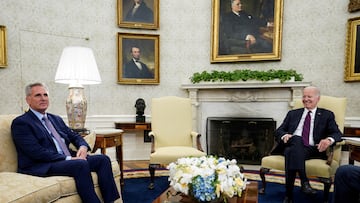Which US Presidents have raised the debt ceiling in recent history and how many times?
Congress controls the nation’s purse strings, passing legislation to fund the federal spending. Likewise, lawmakers must approve how much can be borrowed.

The debt ceiling was born in 1917 as a way to prevent the President Woodrow Wilson from spending too much as the reluctant nation prepared to enter World War I. Since President Herbert Hoover the national debt has increased under every presidential administration and the debt ceiling has been modified 102 times since the end of World War II.
Between 1974 and 1994, when Congress passed budget resolutions, it would also raise the debt ceiling equal to the new spending. Essentially the debt ceiling is meant to cover the cost of spending approved by Congress.
However, the first real fissures in the system appeared in 1985 when the Treasury was forced to implement “extraordinary measures” for the first time. This was the result of a political impasse over how to address the rising US debt. The amount the nation owed had jumped by nearly $1 trillion over the previous six years. The debt limit went from less than $1 trillion to over $3 trillion during the 1980s.
Debt ceiling separated from budget, Congress at impasse to raise limits
in 1995, Congress separated the passage of budget resolutions and debt limit. But after the Balanced Budget Act of 1997, which also raised the debt limit by $450 billion to almost $6 trillion, the US experienced several years of budget surpluses negating the need to raise the limit further.
But deficit spending returned and in 2002 the US once again hit the debt ceiling. However, Congress did not raise it right away and the Treasury was forced to implement extraordinary measures once again. For the next seven years the debt limit was reached annually, and Congress would struggle to agree on raising it, forcing the Treasury to move money around to avoid default. Eventually, though, Congress would raise the debt ceiling to avoid default.
Brinksmanship with the debt limit downgrades US credit
Starting in the 2008 fiscal year, Congress began passing short-term increases instead of doing so on an annual basis. However, in 2011 the US Treasury was once again forced to use extraordinary measures after reaching the statutory debt limit.
However, this time instead of debating an increase of the debt ceiling separately, Republicans, who had taken control of the House in January and now controlled both chambers of Congress, demanded negotiations over spending cuts with President Obama exchange for an increase in the debt ceiling. The Treasury had warned that the US would hit the “X Date” in early August 2011, and just hours before it would have been breached, Congress and the president enact the Budget Control Act of 2011. That implemented a system whereby any additional spending would be matched with cuts to other spending, but the nation was still spending more than it was collecting so the deficit continued to grow.
Concerns over the use of the debt limit as “political bargaining chips” caused the credit-rating agency Standard & Poor’s to downgrade the credit rating of the US for the first time in its history. The Government Accountability Office estimated that the brinksmanship raised borrowing costs by a total of $1.3 billion that fiscal year.
GOP lawmakers want to make debt ceiling a Democratic president’s problem again
Once again the US is on the brink of defaulting and Republicans are using it as leverage to get President Biden to agree to spending cuts. Democrats are crying foul as Republicans raised the debt ceiling under his Republican predecessor, President Trump, without any negotiations on spending. The US Treasury Secretary Janet Yellen has warned that the nation will hit the X Date on 1 June. Failure to reach an agreement or pass a clean debt ceiling increase, no strings attached, before that date is crossed would be catastrophic for the US economy.
Which US Presidents have raised the debt ceiling in recent history and how many times?
| President | Debt ceiling increases |
|---|---|
| Ronald Reagan | 16 |
| George HW Bush | 5 |
| Bill Clinton | 4 |
| George W Bush | 7 |
| Barack Obama | 7 |
| Donald Trump | 3 |
| Joe Biden | 2 |






